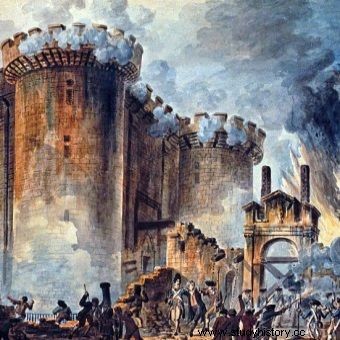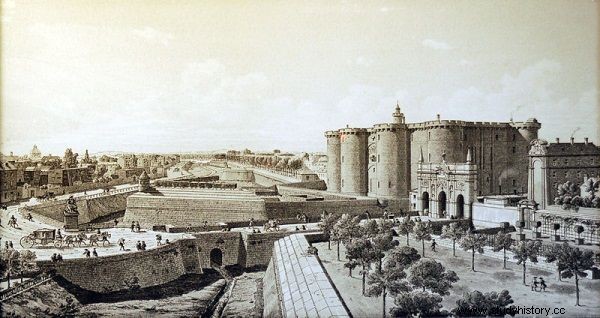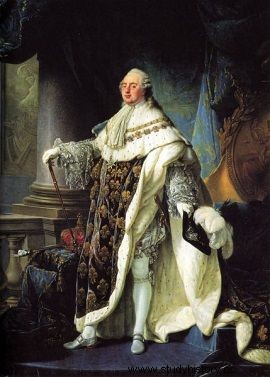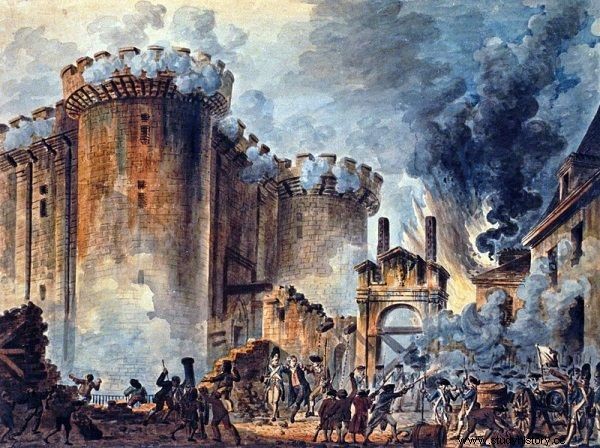Bastille, bastion of torture, oppression and evil. A symbol of dynastic terror, the conquest of which made the great French revolution successful. Or is it all ... just plain rubbish?
It is July 14, 1789. A crowd of outraged citizens hits the most famous Parisian prison. It has one goal:to free the convicts held there in horrific conditions by order of the tyrant and despot, Louis XVI. The revolutionaries conquer the Bastille, free the prisoners and give rise to the most famous revolution in history. The center of evil and hatred is collapsing. 
One of the inmates held in the Bastille, René de Reneville, will describe his place of imprisonment as follows:
A castle where cruelty, suffering and persecution howls,
Which could cause astonishment at the very bottom of hell
Who would terrify the devil if he lived here
Now falls under the wild Bernaville.
Today we can say with certainty:he made up and colored. The vision of the Bastille as the real abode of the devil had nothing to do with reality . The myth of a gloomy prison was formed only with time, out of the need to justify bloody riots. It was all based on fabricated memories and false stories.
A terrifying prison or a heaven for pasibrzuchi?
Monsieur de Reneville complained about his hard experiences in a book on the Bastille, published two years after his release from prison. René was one of many sentenced to imprisonment during the fortress governor of Bernaville, mentioned in the poem.

Louis XIV became a cruel persecutor of prisoners in the eyes of the angered French, although it was he who improved the fate of the prisoners in the Bastille ..
Given that the best writers and journalists of France were among the prisoners, it is hardly surprising that trifles grew under the pens of the masters of the word to the size of great, dramatic stories.
When the revolutionaries conquered the Bastille, driven by tales of "howling cruelty," were absolutely sure they would find secret dungeons and tunnels, shackles, torture devices, and bloodied victims there. They searched very carefully, but to no avail - just like the Americans did for weapons of mass destruction in Iraq. Instead of admitting their mistake, they kept going.
They said that in the captured prison, they discovered abundant evidence of exceptional bestiality, characteristic of a sick system of power.

Mussels for dinner? Or maybe a fresh burgundy with this? I wonder if the Bastille cuisine would deserve a Michelin star?
The gears, which were in fact part of the printing press, were portrayed as an instrument of torture, and the decorative medieval armor was presented as an iron corset in which the condemned man would die in agony.
To see how far these arguments are from the truth, it is enough to look at the story of M. de Reneville, who mourns. When we break through the complaints, we find no less interesting notes that change the point of view a bit. Here is a mention of the first dinner the writer was given after he entered the Bastille walls.
A prison guard covered the table with one of my napkins and served dinner which consisted of a pea soup garnished with lettuce, well warmed up and looking appetizing with a quarter of a chanterelle; on one plate there was a juicy steak with a lot of sauce from the roast, sprinkled with parsley, on the other a quarter of a stuffed dumpling with a great stuffing of thymus, rooster combs, asparagus, mushrooms and truffle, on the third a sheep tongue stew, all perfectly cooked; for dessert, a cookie and two cokes were served.
The guard insisted that he had to pour me some wine. It was a good burgundy, the bread was great as well.
What can I say. Hell, real hell!
The only such prison
Even from the architectural point of view, the Bastille was nothing like a typical prison. It was built as a defensive fortress and only changed its function after a hundred years. It couldn't be wrong, because convicts even protested when they wanted to free them! It was all money owed.

Louis XVI must have been greatly surprised when he learned the significant role assigned to the capture of the old Bastille, guarded by war invalids.
The governor for the maintenance of each inmate received from the monarch amounts corresponding to the rank of prisoner. The highest amounts were allocated to aristocrats and political prisoners, the lowest to people of the commoners (and even such a rate exceeded the daily wage of an ordinary worker).
Moreover, the forced inhabitants of the Bastille were provided with excellent medical care by the standards of the epoch. Stay in the fortress in the 17th century gave a chance to improve the financial conditions of the entire family of the inmate. No wonder not everyone was in a rush to leave.
As if that were not enough, life outside the Bastille walls generally went very freely. The prisoners could visit each other or play boules in the courtyard. The most eminent of them did not have to give up perfume, servants, alcohol or keeping pets behind their walls. There have even been cases when they were allowed to spend the day in the city every now and then and return to their cell for the night.
The facts also contradict the myth of Louis XVI as the persecutor of prisoners imprisoned in the terrible fortress. It was this "tyrant" during his reign that improved the conditions in the Bastille and other prisons. It banned the use of torture, the use of cold and damp dungeons, and introduced the obligation to indicate the estimated length of time in prison.

Louis XVI must have been greatly surprised when he learned the significant role assigned to the capture of the old Bastille, guarded by war invalids.
The Black Legend of the Bastille is the work of those held there. Many imaginary stories and stories have been written, such as "Diaries of the Bastille" by Simon Nicholas Linguet or "The History of the Bastille" by the aforementioned M. de Reneville.
Books of this type aroused widespread admiration and sympathy for former prisoners. In a sense, it was a great opportunity for them to come into existence in the world of a new social order. They did it so well that to this day many textbooks describe the Bastille as a bloody symbol of overthrown tyranny. On the other hand, the 14th of July is still the French national holiday, celebrated with loudness.
Bibliography:
- Frunck-Bretano Frantz, Legends of the Bastille, London:Downey and CO, 1899.
- Linguet Simon-Nicholas-Henri, Memoirs of the Bastille, Chez Jim Books, 2005.
- Pernoud George and Sabine Flaissier, The French Revolution , London:Secker &Warburg, 1961.
- Weir William, The greatest lies in history , MUZA SA, Warsaw, 2010.
